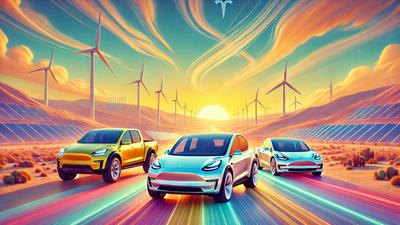As the popularity of electric vehicles continues to rise, Tesla remains at the forefront of EV innovation. So it’s no surprise that the automaker has also completely redefined electric vehicle charging.
Superior equipment, innovative technology, a robust network, and reliable performance have allowed Tesla to excel not only at building their fleet of popular EVs, but powering them as well. From its Supercharger technology to its vast nationwide NACS charging network, Tesla continues to lead the way into the electric future.
In this comprehensive guide, we'll delve into the importance of home charging, why Tesla is considered the top standard, the installation process of Tesla chargers, and the benefits of choosing Tesla for your charging needs.
Tesla Home Charging Options
One of the most significant considerations for EV drivers is battery charging. Public charging stations are still some time away from reaching the ubiquity of gas stations. Until the infrastructure has been built, many potential EV drivers worry about becoming stranded miles from the nearest charging station with no way to power their cars.
Setting up a home charging station can help alleviate this so-called “range anxiety” and ensure that you can conveniently and reliably charge your EV from the comfort of your home, saving you time and money. Home charging stations are cheaper and more accessible than public charging stations. They also allow EV drivers to charge their cars and trucks during off-peak hours, minimizing energy costs.
Tesla Charging Levels
For Tesla drivers, there are a few options to choose from when it comes to charging, each running on different levels of voltage. Let’s take a look.
Level 1 Charging
Level 1 charging, also known as “trickle charging”, utilizes standard 120V electrical outlets found in most homes. Tesla owners can charge on these outlets using a NEMA 5-15 adapter that comes with each new vehicle. 120V outlets deliver 1.4 kW of power and provide three miles of Tesla range per hour of charging.
Level 2 Charging
Level 2 chargers utilize 240V electrical outlets, similar to those used by electric stovetops and dryers. These are the most common electric vehicle home chargers, found in Tesla Wall Connectors, Mobile Connectors, as well as the majority of public charging stations. Level 2 chargers deliver 3.7-17.2 kW of power and provide up to 44 miles of Tesla range per hour of charging, depending on which charger you have and which Tesla model and trim you are charging.
Types of Tesla Level 2 Chargers include:
Tesla Wall Connector
- Optimal, fast charging at home
- Cost: $475
- Estimated Installation Cost: $750-$1,500 (if you have an existing outlet approved for charging by your installer, no installation is required)
- Compatibility: Tesla
- Charge Speed: up to 44 miles per hour
- Plug Type: NACS
- Cable Length: 24 feet
Tesla Mobile Connectors
- Portable, convenient charging on-the-go
- Adapter allows mobile charger to connect to 120V and 240V outlets anywhere
- Cost: $230
- Estimated Installation Cost: $750-$1,500 (if you have an existing outlet approved for charging by your installer, no installation is required)
- Compatibility: Tesla
- Charge Speed: 3-30 miles per hour
- Plug Type: NACS
- Cable Length: 20 feet
Tesla Universal Wall Connector
- All-in-one charging solution
- Cost: $595
- Estimated Installation Cost: $750-$1,500 (if you have an existing outlet approved for charging by your installer, no installation is required)
- Compatibility: All EVs, including non-Tesla electric vehicles
- Charge Speed: up to 44 miles per hour
- Plug Type: NACS & J1772
- Cable Length: 24 feet
Level 3 Charging (Superchargers)
Level 3 chargers, also known as direct current fast (DC fast) chargers, utilize high-powered 480V circuits and are typically found only at select public charging stations. Tesla Superchargers are Level 3 chargers. These ultra-fast charging connectors can deliver up to 250 kW of power and provide up to a whopping 170 miles of Tesla range in just 30 minutes of charging time.
Can I Install a Supercharger at Home?
While Level 3 chargers, particularly Tesla Superchargers, are the gold standard due to their fast charging times, they are not suited for home use for a number of reasons.
High Cost
The hardware that comprises Superchargers is very expensive. While Tesla doesn’t list a price for Superchargers on its website, companies that have purchased them in the past have reported that even 60 kW versions of the charging station hardware can cost up to $20,000, and that’s before adding installation costs and any additional electrical work.
Battery Life Degradation
Superchargers are great when you’re on the go and need a quick “fill up” of power. However, using a Supercharger frequently can degrade your EV battery. The intense power of these Level 3 chargers causes the batteries to experience greater heating, which can reduce the maximum charge capacity over time. Tesla has even gone so far as to restrict the number of times a Tesla vehicle can use DC fast chargers to avoid a significant impact on the battery’s health.
No Availability
Lastly, due to the reasons above, Tesla doesn’t officially sell their Superchargers to individuals, and it’s unlikely they would make an exception, even if cost wasn’t an issue. And besides, Level 2 Tesla chargers and the occasional Supercharge on a road trip or long drive are usually more than sufficient for most drivers and their needs.
DIY or Hire an Installer?
Tesla has trained certified installation technicians available to inspect your electrical systems and install your home charging station. These experts can help you select the right charger for your situation and needs, provide a quote, and complete the installation at your home.
The installer will typically include the following standard items in your installation quote:
- Professional installation service and materials
- Electrical permit
- Inspection
- Installation warranty
Installers may also include additional items necessary for more complex installations:
- Long wire run (distance from electrical panel to installation site)
- Additional electrical panel
- Trench (underground wires)
- Main panel upgrade
- Pedestal installation
- Hiding cables behind walls
While the installation instructions are fairly straightforward, the process requires a basic understanding of household wiring and local electrical codes. In addition, if you are uncomfortable wiring high-current, high-voltage power, it’s better to hire a licensed electrician or certified Tesla installer to perform the installation.
Step-by-Step Guide to Installing a Tesla EV Charger
- Evaluate your Electrical System. Before installing a Tesla home charger, assess your home's electrical system to ensure it can support the charger's requirements. You may need to consult an electrician to determine if your electrical panel has enough capacity and if any upgrades are necessary.
- Make Necessary Upgrades to Electrical System. If you have an existing outlet approved for charging by your electrician, no installation is required. If not, installing a new 240V outlet typically costs $750-$1,500.
- Note: Charging speed is up to 3 mph with a standard household outlet or up to 30 mph with a 240 V outlet.
- Select a Location. Choose a suitable location for the charger. It should be easily accessible for your Tesla vehicle and close to your electrical panel to minimize installation costs.
- Choose the Charger Model. Tesla offers different home charging options, including the Wall Connector and the Mobile Connector. Decide which model best suits your needs based on factors like charging speed, installation flexibility, and budget.
- Purchase the Charger. Once you've selected the charger model, purchase it from Tesla's website or an authorized retailer.
- Prepare for Installation. Gather the necessary tools and equipment for installation, including a screwdriver, drill, mounting hardware, and electrical wiring materials. Turn off the power to the installation area at your electrical panel.
- Install the Charger. Follow the installation instructions provided by Tesla for your chosen charger model. This typically involves mounting the charger to the wall, connecting it to the electrical panel, and configuring any settings or options.
- Connect the Charger to Your Vehicle. Once the charger is installed and powered on, connect it to your Tesla vehicle using the appropriate charging cable. Your vehicle should automatically start charging when connected.
Saving Money on Your Home Charging Station with EV Life
There are a variety of federal and state EV incentive programs out there to help you save money on the purchase of a Tesla. The federal EV tax credit, the Colorado EV Tax Credit, the Clean Vehicle Assistance Program, and other state and local programs all offer different tax credits, rebates, and grants to encourage drivers looking to make the switch to electric. There are also a number of additional incentives that can help you save on Tesla charger installation.
Power companies like PG&E, Xcel Energy, and other utilities offer rebates for qualified drivers that can save hundreds of dollars on the cost of your Tesla home charging station. And when you finance your electric vehicle purchase through EV Life, we can help you find and apply for every incentive you’re eligible for.
At EV Life, we’re on a mission to make it easier and more affordable for anyone to save on driving electric–including you!
With a free EV Life account we help you:
- Maximize your tax credits and rebates. We prequalify your incentives up front and help you apply for all your incentives pre- and post-purchase with our easy-to-use “Turbo Tax-style” incentive filing tools.
- Prequalify for low rate EV loans. Based on the EV you want and your credit score, score a prequalified loan offer that beats traditional loan payments.
- Bundle charging. EV Life can also help you get an instant quote for a home charger + installation – and you can even bundle it into your EV loan.
Open a free account today and start saving on your EV.






